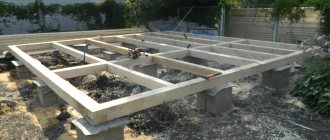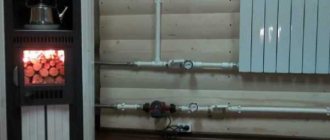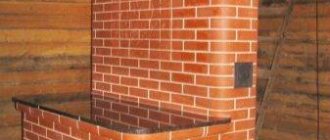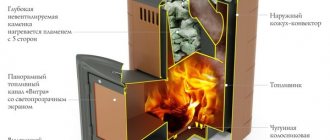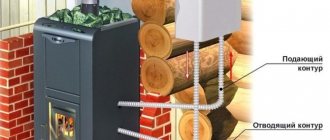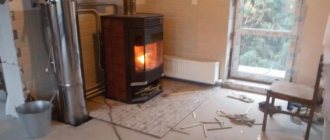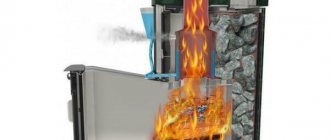And so, important criteria when choosing a stove for a bath:
Furnace power.
The most important thing you need to consider when choosing a stove for a sauna is that the power should be optimal. You can buy a stove made of steel, cast iron, wood, gas, electric, cheap or expensive, any criterion can apply, except for one thing - it must correspond in power to your steam room. The issue of heater power can be neglected only in one case: if you have built a hammam, where there is no sauna stove in the usual sense. Incorrectly chosen power will lead to unpleasant consequences, which we will consider further.
Excess power.
It happens that people want their steam room to warm up faster. In this case, they purchase a stove with a large power reserve; yes, the steam room will warm up faster in this case, but this is only at the beginning. Then the oven will work at the minimum of its capabilities. This is a welcome sign that your steam room will be filled with hot air, but the stones will remain cold, on which it is useless to pour water - there will be no steam from them, and if there is, it will be in clouds and white, like when a kettle is boiling, and not that light and transparent as you expected.
Lack of power.
A completely different extreme is to purchase a stove with minimal power just to save money. Of course, the stove will be able to heat the steam room to the required temperature. But it will have to work to the limit, in this mode the stove will not serve you for long and will entail replacing the stove, spending time and money on dismantling and installation. Ultimately, running your oven to its limits is simply not safe.
Calculation of the optimal power of a sauna stove.
Now the next question: what is the optimal power? All manufacturers indicate for each model not only the power in kilowatts, but also the recommended steam room volume. To make the calculations easier, we will not delve into the details, and we will take the cubic capacity of the steam room as a basis. It's much easier to count this way.
Determining the cubic capacity of the steam room
If you built your bathhouse according to a project, then you will not have problems determining its volume - it is in the project. If there is no project, then you will have to work with a tape measure. We measure the steam room, write down the results, multiply them together and you get the volume of your steam room. It would seem that the volume has been obtained, and you need to select a sauna stove for it, but no, there are a number of nuances that need to be taken into account. If you have uninsulated areas in your steam room, for example, brickwork, stone cladding, windows... then you need to calculate the area of these areas. Then multiply by 1.2 and add to the cubic capacity obtained earlier. If you have a glass door installed in your steam room, then add another 1.5 m3 to the resulting volume. If your steam room is made without interior decoration, then multiply the volume by 1.5.
Example: let's say we have a steam room with dimensions of 2.5x2x1.5 meters. Then, under ideal conditions, its volume will be: 2.5 * 2 * 1.5, which is equal to 7.5 m3. If a glass door is installed in the steam room, then add another 1.5 m3 to the resulting volume and get 16.5 m3. If there is no finishing in the steam room, we multiply the resulting volume by 1.5, resulting in 22.5 m3 - the cubic capacity of the steam room without finishing, therefore, you need to select the stove for this volume. If you do not want to do the calculations yourself, then you can always contact our specialists.
Now you know the volume for which the sauna stove you need should be designed. And don't forget about the stones. To fully utilize the heater’s thermal power, you should load it with as many stones as the manufacturer recommends. This parameter is also indicated for each model.
Furnace material.
It is no secret that the quality of the stove material is an indicator of how long the stove will serve you. Nowadays, the leading positions on the market are occupied by stoves made of steel and cast iron. But which material is better? Steel or cast iron? Let's figure it out.
No. 1. Criteria for choosing a stove for a bath
The issues of choosing a reliable and durable stove must be addressed before the construction of the bathhouse begins, at the design stage . This approach will allow you to calculate in advance the main parameters of the equipment, organize the necessary foundation, and provide options for installing the furnace. In this case, the main criteria for selection are:
- type and design of the stove, type of fuel used;
- power and performance, compliance of the specified parameters with the size of the steam room and bathhouse as a whole. Insufficient power leads to wear and tear on the equipment. Too high a performance means rapid heating of the room with insufficient temperature of the stones, which leads to an imbalance in the adoption of health procedures;
- operating principle of the furnace. Classic models require constant maintenance. Long-burning stoves can provide heat for 4-6 hours without requiring your intervention;
- availability of a water tank;
- presence of convection function;
- steam quality The stoves are equipped with open or closed heaters. In the first case, light, dry steam is created in the steam room, in the second - wet steam.
When choosing a kit, it is advisable to read the operating instructions, pay attention to the safety of the model and its compliance with the requirements of current standards. Reviews from users who have already purchased the selected model will also help with the choice.
Conclusion
Which sauna stove is best to choose for a Russian sauna? It is impossible to give a definite answer, but it is worth choosing between wood-burning and electric stoves, because... gas is not supplied everywhere. Next, the main criterion for selection is the power of the furnace. We have given the calculation formula above. The remaining parameters depend on your desire and wallet.
Having correctly determined the initial data, selecting a stove for a bath according to the parameters is not difficult. All characteristics are indicated in the product passport. Among manufacturers, the Finns confidently hold the first place, offering, among other things, fairly budget-friendly systems. The presence of a Russian-language website and the design of the case also influence the choice, which is not at all as small as we would like.
No. 2. Sauna stove material
If in ancient times stoves were made only of brick , today they have an alternative - steel and cast iron products . As you might have guessed, they all have their own strengths and weaknesses, but they also have some things in common. The higher quality material was used, and the thicker the walls of the stove, the longer it will last.
Brick oven
Brick kilns are becoming less and less popular today. There are several reasons. The main thing is that it is difficult to find a specialist who would competently lay out such a stove . And in Rus', the ability to install a sauna stove was considered an art, all the nuances were kept secret, but now it is almost impossible to find a decent stove maker.
Advantages:
- retains heat for a long time;
- warms up a large area;
- good fire safety;
- authenticity. If you want to take a steam bath in a real Russian bathhouse, then build a brick oven.
Flaws:
- the complexity of construction, sometimes it is impossible to find a specialist;
- heaviness. The average stove weighs about 1200 kg, which means that a reliable foundation must be prepared for it;
- high cost due to the need to pay for the work of a professional and create a foundation;
- dimensions. The brick oven will take up a significant part of the steam room;
- It takes a long time and is difficult to melt, but also retains heat for a long time.
Also, experienced bathhouse attendants note that to get steam, you need to splash water on the stove, and the smell of wet brick is not very pleasant. A brick stove, of course, looks gorgeous, but you can cheat and lay a brick screen around a steel product .
Steel furnaces
They are considered the best option. The stoves are made of chrome steel; people call them “clean air” because they do not burn oxygen. The stoves are sold ready-made; they do not require any special secret knowledge for successful installation.
Advantages:
- ease of installation;
- light weight, so a separate foundation is not required;
- compactness;
- ease of kindling;
- quick heating of the room.
Flaws:
- rapid cooling of the room;
- to maintain the optimal temperature in the steam room, you will need to constantly heat the stove, since metal has a low heat capacity;
- the fire will have to be maintained constantly;
- the power to warm up a large area may not be enough;
- low level of fire safety.
Cast iron stoves
In terms of popularity, cast iron stoves are only slightly ahead of brick stoves. Almost no one uses them anymore either. There are a lot of reasons, but such units also have a lot of advantages, so think about it before choosing.
Advantages:
- high heat capacity and heat transfer;
- durability up to 40 years;
- ease of kindling;
- safety.
Flaws:
- heavy weight, so you will have to build a foundation;
- high price;
- Cast iron is a brittle material that can crack or split during transportation or significant mechanical stress.
It is worth mentioning the so-called potbelly stoves , primitive structures with a pipe and a door. Of course, such equipment can be used, but it is still a relic of the past, which is inferior in functionality and safety to modern analogues.
No. 3. Sauna stove power
The dimensions of the steam room play a decisive role when choosing the power of the product. In order for the temperature inside the steam room to be optimal for the body, the bath should not be overheated. With too much power, the air will be hot and the stones will be cold. If you choose a model that is insufficient to warm up the steam room, it will take a long time to heat the bathhouse with corresponding energy costs. In this case, the service life of the furnace will be significantly reduced. In general, the furnace should have optimal power and, preferably, a sufficient range of its regulation.
The method for calculating the required power is as follows:
- calculate the volume of the steam room. For example, for a room measuring 3*2 and a ceiling height of 2.3 m, the volume will be 13.8 m3;
- calculate heat loss from cold surfaces (windows, doors). We calculate the area of these surfaces and multiply it by 1.2, since each such square meter absorbs the heat necessary to heat 1.2 m3 of volume. Let's say in a steam room there is a window 0.5 * 0.8 m (area 0.4 m2) and a door 2 * 0.9 m (area 1.8 m2). The total area of cold surfaces is 2.2 m2. It is necessary to increase the calculated volume by 2.2*1.2=2.64 m3;
- We summarize the obtained indicators. Yields 16.44 m3;
- We make allowances for the material of the bathhouse. If the bathhouse is made of logs, without finishing (minimal thermal insulation), then the result is multiplied by 1.6. If the inside of the bathhouse is lined with clapboard and there is a layer of insulation (maximum thermal insulation), then you can take a coefficient of 0.6. Let's say our bathhouse cannot boast of high-quality thermal insulation, then 16.44 * 1.6 = 18 m3, which means we need an 18 kW stove. It is better to take with a margin of 20%.
Power range , i.e. The ratio of minimum and maximum power is ideally 1:10. Such a furnace can operate at both 3 kW and 29 kW. The power in furnaces is regulated in several ways:
- you can regulate the amount of fuel supplied. Convenient for gas stoves, but not wood stoves;
- limiting the amount of incoming air. Option for wood burning stoves;
- release of excess heat into the environment. Literally - open the door and ventilate the steam room.
If the manufacturer has not indicated the power of the furnace, then it can be approximately calculated by multiplying the volume of the firebox by 0.5.
Review of the best models
We will review sauna stoves for three rooms with a water tank according to the characteristics described above, considering the pricing policy and the pros and cons.
Gorynych-3
An excellent heater with a grateless principle of longitudinal combustion, high efficiency and durability are guaranteed. The stove is located between the washing room and the steam room, warming the steam room by 80 degrees, and the washing room by 35, part of the firebox warms the floor, the rest room is warmed to 25.
- Efficiency 80-90%.
- Fuel - firewood.
- Manufacturing material – high quality steel.
- Weight 200 kg.
- Wall thickness 8 mm.
- Size 920x775x1000 MM (Height, depth, width).
- The volume of the steam room is 8-18 cubic meters, the washing room is 10-18 cubic meters.
- Price – 40-50 thousand rubles.
Installation diagram and example:
Advantages:
Durability. Service life more than 15 years. High efficiency, well warming adjacent rooms. Thick walls, 100 liter tank, weight of stones - 100 kg. Excellent reviews about the stove.
An innovative furnace system that allows you to clean ash less frequently and increase efficiency to high values. A fireplace door with a glass insert allows you to admire the fire and monitor the condition of the firewood. Large combustion chamber, large logs can be placed.
Flaws:
Large mass, average price, but not budget. Glass has to be washed from time to time.
Sauna fireplace "Gorynych"
A stove for a bathhouse for 3 rooms from the Gorynych company, a high-quality heater with a 100-liter tank. A fireplace that allows you to see the play of fire in all its glory and monitor the condition of the fuel. Huge volume of heated space. Screw chimney.
- Efficiency 80-90%.
- Fuel - firewood.
- The material of manufacture is steel enameled with heat-resistant enamel.
- Weight 260 kg.
- Wall thickness – 8 mm.
- Size 920x775x1000 mm.
- The volume of the steam room is 8-18 cubic meters, the washing room is 10-18 cubic meters, the rest room is 50 m^3.
- Price 60 thousand rubles
Advantages:
Panoramic glass door. The volume of the heated rest room is 50 cubic meters. Built-in air heating system. Service life more than 15 years. Great reviews. Fast heating in winter.
Flaws:
High price and large mass of the oven.
Berezka 24 with a 50 l tank
A heater with a tank that combines convenience, high efficiency and high-quality assembly. The hinged tank is located on the left or right side, depending on the wishes of the owner and can be easily removed and put on the other side.
- Efficiency 80%.
- Fuel - firewood.
- Manufacturing material - steel 09G2S.
- Weight 115 kg.
- Wall thickness 6-8 mm.
- Size 780x690x640 mm
- The volume of the heated room is 12-24 cubic meters.
- View - open.
- Price – 20 thousand rubles.
Advantages:
A heater with a tank of 50 liters of water quickly heats up to 100 degrees a room of up to 24 cubic meters. The walls are thick, up to 8 mm in loaded areas. A large tank saves money and the price of this heater is reasonable. Reviews talk about the durability of the heater.
Flaws:
The sauna easily overheats and it is often difficult to create good steam; it is more suitable for saunas.
Varvara Malyutka
Stove for three rooms in the bathhouse, remote firebox and tank, wood heating. 40 liter water tank. It produces steam easily and well. A carefully thought-out design heats the stove evenly.
Cold air passes into the ash scoop and warms up as it passes through the stove; the heating intensity is adjusted using the ash scoop.
- Efficiency 80%.
- Fuel is classic wood.
- Material – steel.
- Weight 78 kg.
- Wall thickness 6 mm.
- Dimensions 740x620x380 mm.
- Steam room volume – 12-16 m^
- Price 15 thousand rubles.
A budget option for a small bathhouse.
Advantages:
The stove is a domestic company that has been on the market for more than 20 years; the development of the model has absorbed all the good qualities of previous models. Low price, good efficiency, uniform heating of the heater, durability.
Flaws:
Small sizes, which is not suitable for medium and large bath rooms.
Favorite 24
Warming up the steam room with the Favorit 24 stove will provide pleasant, soft, finely dispersed steam. Convection occurs inside the housing and distributes heat evenly. 50 liter tank. Panoramic door. Characteristics:
- Efficiency 82%.
- Fuel - firewood.
- Material – steel.
- Weight 120 kg.
- Wall thickness 6-8 mm.
- The volume of the steam room is 12-24 cubic meters.
- Price 25 thousand.
Advantages:
A stove of average price, for a medium-sized bathhouse, excellent heating and high-quality assembly from a domestic manufacturer. Medium sized tank. Nice design and panoramic door.
Flaws:
No. 4. What fuel does the stove run on?
Wood stoves
Wood-burning stoves are a classic option for a Russian bath. With the help of such models, a special atmosphere of comfort and coziness is created in the room. Wood-burning fireboxes are practical, durable, easy to use, and wood is an affordable and ubiquitous material. If there are problems with gasification and electricity in the region, then firewood is the only option.
pros:
- no additional communications are required, there is no dependence on supply companies;
- Providing fuel for a wood-burning sauna is quite simple. It is possible to purchase the material or prepare it yourself;
- depending on your preferences, you can purchase different types of firewood, differing in composition, productivity, and efficiency of use;
- pleasant aroma of wood;
- wide range of stoves.
Minuses:
- you will have to build a chimney and clean it periodically;
- When fuel burns, ash is formed, which must be regularly removed from the ash pan and chimney;
- using wood to heat a steam room is more difficult and takes longer than using alternative fuels;
- you will have to constantly add firewood.
The result of firing a wood-burning stove largely depends on the quality of the wood and even the skill of the stoker.
Gas ovens
Sauna stoves operating on gas have a large mass and corresponding dimensions, and their connection must be made with the assistance of qualified specialists. Installing such a structure relieves the owner from constantly monitoring the flame level and lining the firewood. Mains or bottled gas can be used.
pros:
- compactness. Unlike wood-burning stoves, gas stoves do without a firebox and ash pan, so they are just right for small steam rooms;
- there is no need to monitor the availability of fuel. True, in the case of bottled gas, one must not forget to fill or change the cylinders;
- the indoor temperature can be controlled by changing the fuel supply intensity;
- no need to clean ash:
- operational heating of the room.
Minuses:
- the need to connect to the gas pipeline, but this is impossible without the involvement of a specialist. If there is no gas in the region, you will have to use cylinders, and this is not entirely convenient;
- The fire hazard of gas furnaces is higher than alternative options.
When purchasing a gas stove, carefully study its technical data sheet. You can only trust trusted and reputable manufacturers and stores - no private traders. It is better not to buy used gas stoves; there is a high risk that they do not work exactly as they should.
Electric ovens
Electric sauna stoves do not have a chimney. The advantage of such models is the absence of carbon monoxide, which eliminates the possibility of poisoning by combustion products. The power of such equipment is selected based on the size of the room, but the energy consumption of electric furnaces is quite high. Today, electric ovens are considered the most popular and are available in a wide range.
pros:
- compactness and light weight;
- fast and uniform heating;
- ease of use, flexible settings, functionality;
- no chimney, so you don’t have to build or clean anything;
- low cost;
- does not require a gas connection;
- fire safety.
Minuses:
- Electric ovens are not suitable for areas with frequent power outages. You can, of course, use a generator, but this is not very convenient;
- cost of operation.
When connecting, make a separate grounding circuit for the oven.
There are also combined types of stoves, for example, gas and wood. Such a product will be bulky, but practically universal.
Types of stones
Since the heater as a stove element is a volumetric storage of stones heated by the heat of the firebox and used as a steam generator, it is of great importance what rocks are used to perform these tasks.
Expert opinion
Lovkachev Boris Petrovich
Bath master who knows everything about steaming
It is necessary to immediately take into account that it is rocks of igneous origin that are required. Sedimentary types - limestone, sandstone, etc. - will not work.
Due to sudden temperature changes when heating and supplying water to create steam, such stones will quickly crumble into sand. In addition, these stones are too loose and do not have sufficient heat capacity (cool quickly).
Among connoisseurs, the following breeds are most preferred:
basalt
This is solidified lava that erupted from a volcano. It is considered the best option for a bath. There are subtypes of basalt - dolerite, anamesite, diabase;
nephritis
The most durable stone - even under conditions of daily use, it retains its working qualities for up to 10 years;
jasper
The best option for a bath is wax jasper, which has a uniform structure. It is not recommended to choose multi-colored (beautiful) jasper, as it can be destroyed due to the difference in thermal destruction of the layers;
gabbro-diabase
A good and inexpensive stone for a bathhouse, capable of maintaining working qualities for a long time. It is necessary to choose stones without sulfites so that they do not emit any odors when heated;
blows
This rock is formed at great depths under high pressure conditions, which makes the stone strong, durable and heat-intensive. Suitable for the bottom of the heater and for filling the entire compartment;
jade
A very good stone for a bath. There are many legends about him, but many of them turn out to be reality when tested. This type of stone rarely comes to the surface, therefore, jadeite is expensive.
It is not recommended to use:
granite
This stone is completely unsuitable for a bathhouse, as it has a grainy structure and quickly begins to crumble;
white quartz
It is credited with a lot of beneficial properties - skin rejuvenation, air ozonation. However, these are all myths. White granite quickly collapses and is practically unsuitable for use in a bathhouse;
coil
This is a stone that is sold by many companies. Various healing qualities are attributed to it, but you should not purchase a coil - it does not possess any useful qualities and is completely unsuitable for use in a heater.
You should choose a stone based on the basic requirements:
- high hardness, density;
- homogeneous structure, absence of inclusions;
- medium size, the ability to tightly pack stones in the compartment.
If the stones are heavy, have a uniform color and split with great difficulty (or do not split at all), then they can be used for a heater.
Variegated beautiful stones should be discarded immediately - they will quickly crumble. In addition, we must remember that some rocks emit radiation, therefore, it is recommended to choose the material meticulously and carefully.
No. 5. Firebox location
Depending on the location of the firebox, stoves are:
- with an extended firebox;
- with the classic one.
Stoves that are mounted between the steam room and the dressing room have an elongated firebox The stove can be heated from the dressing room, which has a positive effect on fire safety and convenience. The one who throws firewood will in no way interfere with those who are steaming, and there will be less dirt in the steam room, and the microclimate in it will be better. A conventional firebox is located in the steam room itself.
Bathhouse with steam room and sink in one room: advantages and disadvantages
A bathhouse with a combined sink and steam room is not so common at the moment. This option is chosen mainly if the area of the site does not allow for two separate rooms.
Another advantage is that a bathhouse, where the steam room and washing room are combined, is much more pleasant to visit in winter: it heats up quickly and is quickly ventilated. In summer, on the contrary, it is quite difficult to cool the washing room.
A bathhouse with a combined sink and steam room has significant disadvantages. The first of them is due to the fact that with such a design it is much more difficult to maintain the necessary conditions in the steam room. In particular, if someone washes in the washing room, the humidity level in the room will increase, and the steam room will be less comfortable. And the smell of soap or shower gel also interferes with creating the desired atmosphere.
Any bathhouse should be equipped with a sink and a steam room. To effectively use space, many owners install a special stove. It divides the bathhouse into two rooms.
No. 6. Steam source
Sauna stoves can be conventional or with a steam generator . What is the last one for? And in order to provide the room with a sufficient amount of steam when the stove itself cannot cope. The first sign of a real Russian bath is dry and light steam. Not all modern ovens are capable of producing it in sufficient quantities.
Light steam is obtained at a temperature in the steam room of 850C. In this case, finely dispersed steam is obtained when water hits stones heated to 5000C. With such heating, the air temperature certainly rises, to incredible limits, and as a result, you can get a burn. To prevent this from happening, they created ovens with a steam generator . It warms up much faster than the stones and saturates the steam room with the necessary steam, while the air temperature in it remains optimal.
No. 7. Cold and hot ovens
Depending on how hot the walls are, ovens can be:
- hot , the surface heats up to 1000C, so the steam room quickly becomes warm. Such stoves are great if there is no constant heating in the bathhouse. The downside is the inability to control the temperature in the steam room, to the point that the air can become very hot;
- walls cold ovens they heat up to 45-500C, cold air is taken in through special channels, and it returns in a heated state. The thermal regime is stable, humidity and temperature can be adjusted. It will take a long time for the steam room to warm up, but if you are not in a hurry, you will appreciate all the advantages of these stoves.
Bathhouse with steam room and sink in one room: advantages and disadvantages
A bathhouse with a combined sink and steam room is not so common at the moment. This option is chosen mainly if the area of the site does not allow for two separate rooms.
Another advantage is that a bathhouse, where the steam room and washing room are combined, is much more pleasant to visit in winter: it heats up quickly and is quickly ventilated. In summer, on the contrary, it is quite difficult to cool the washing room.
A bathhouse with a combined sink and steam room has significant disadvantages. The first of them is due to the fact that with such a design it is much more difficult to maintain the necessary conditions in the steam room. In particular, if someone washes in the washing room, the humidity level in the room will increase, and the steam room will be less comfortable. And the smell of soap or shower gel also interferes with creating the desired atmosphere.
Any bathhouse should be equipped with a sink and a steam room. To effectively use space, many owners install a special stove. It divides the bathhouse into two rooms.
No. 8. Heater type
Furnaces can be:
- with open heater. Flue gases heat the walls of the stove and the buried stones. You can start steaming literally immediately, but cooling down occurs quickly. These are safe stoves; soot does not accumulate on the stones; however, more fuel is consumed here than in stoves with a closed heater, but you can stay in the steam room as long as you like.
- with a closed heater. In such furnaces, the stones are heated not by the metal, but directly. To obtain the desired temperature, the oven must be heated for several hours, but then it itself maintains heat for 10-12 hours. Such stoves were previously used in public baths, but now they are rarely used. The efficiency here is much higher, but you won’t be able to steam until the stones are completely warmed up. Soot collects on the stones, and safety is somewhat lower.
No. 9. Technical equipment of the furnace
Pay attention to convection ovens . They provide optimal air exchange in the steam room. Due to the design of the heater and the protective casing, the heating temperature of the air is quickly equalized, and there is a constant movement of cold and hot air masses. Non-convection ovens require more time to create optimal conditions in the steam room.
The stove can be equipped with a tank for heating water . The container can be built-in or remote. The first option is suitable for a steam room designed for 2-3 people and will provide them with a sufficient amount of hot water. The portable tank is installed in bathhouses with high visitation rates.
If there is a need to heat adjacent rooms (dressing room, shower, locker room), then you can take a stove with a heat exchanger . As a rule, a combined heating principle is used. The steam room is heated by convection, and adjacent rooms receive heat through the flow of heated coolant through radiators.
How to choose?
To know how to choose a stove for a sauna with a separate steam room and sink, you should use the following tips:
- The fryer must have high thermal power, sufficient to heat the steam room and water in the washing room, as well as provide steam. For each room, this indicator is individual and depends on the size of the heated area and the material from which the bathhouse is made.
- A properly selected design is compact in size, easy to use and eliminates the possibility of fire.
- The stove must be equipped with a high-quality steam generator and heat accumulator. This is necessary in order to easily set the desired mode that determines the type of bath: from real Russian to dry Finnish.
- It is necessary that the roaster be equipped with tools to adjust the convection.
- There should be no significant areas on the furnace structure whose temperature may exceed 150 degrees.
- If you are offered a brick or metal Dutch oven, opt for the latter option. Metal stoves are capable of heating a steam room with high speed and efficiency, take up less space, do not require a foundation, and are easy to use and maintain.
This is what a sauna stove with a separate sink and steam room looks like:
No. 10. Furnace shape
The shape is the last thing people pay attention to, and then they consider it more from the point of view of dimensions. It is worth noting that classic rectangular ovens are a priority. They are more stable and heat up evenly, which cannot be said about cylindrical models , the upper and lower parts of which are heated differently.
